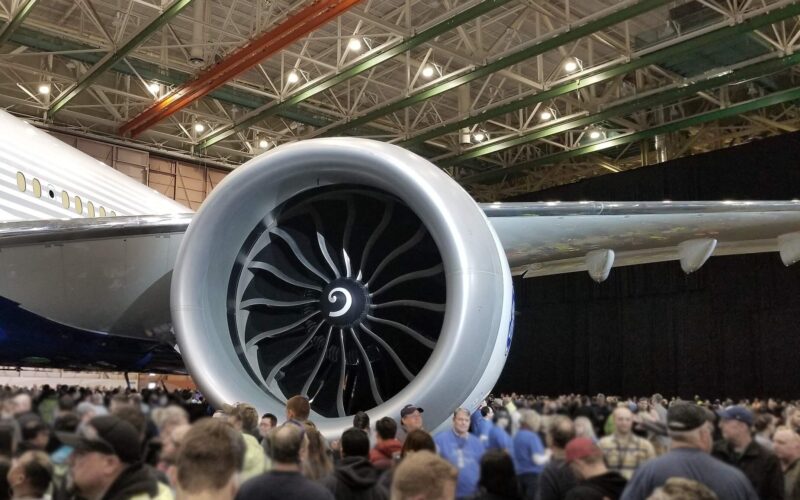All commercial aircraft designed during the last 40 years are powered by gas turbine engines. These are either turbofan or turboprop. Currently, and judging by the number of deliveries made across the globe, the best-selling jet engine is the turbofan. And among the turbofans is an engine model, which presently holds the title of the world’s largest engine. However, a competitor might well usurp this position. Here, AeroTime investigates the biggest commercial aircraft ever made.
The GE9X
To date, the largest commercial aircraft engine available in the market is the GE9X, which is made by the American manufacturer, General Electric.
The GE9X, which currently holds the Guinness World Record for the highest recorded thrust, was first introduced in April 2016 and received Federal Aviation Administration approval in September 2020. The engine was designed to power the Boeing 777X wide-body aircraft. One variant, the 777-9, made its maiden flight in early 2020.
The GE9X was developed from its predecessor GE90, which is used to power the Boeing 777 aircraft and its variants, including the 777-200, 777-200ER, 777-300, 777-200LR, and the 777-300ER. The engine is famous for its size as the diameter of the GE9X front fan reaches 340 centimeters, while its total diameter is close to four meters. In comparison to GE90, the GE9X has a larger fan and lighter construction. The largest GE90-115 model includes a fan diameter of up to 330 centimeters. The measurements of the GE9X mean that the giant engine is even wider than even the fuselage of a Boeing 737 Classic jet.
The GE9X is notable for its thrust capabilities. According to its manufacturer, the engine is able to produce 105,000 pounds of thrust for a total of 210,000 pounds. The Boeing 777X motor has even hit 134,300 pounds of thrust, which is a world record. However, some aircraft engineers have dismissed the likelihood of flight crew needing such thrust to propel the jet off the ground. Meanwhile, the ancestor GE90-115 is capable of providing a thrust of up to 115,540 pounds.
The GE9X is also well-known for its curvy, carbon fiber-made blades, which form the spinning fan. The GE9X has 16 blades whereas the GE90 engine has 22. The new technology allows the blades to make a little more twist in the proper areas and provides this way, providing the GEX9 with an extra lift when needed.
The engine includes both low and high-pressure turbines, a core, and a compressor. But the innards of turbofan engines are more complex. Inside the warmest part of the engine (the high-pressure turbine), the temperature can reach up to 2,400 degrees Celsius, which, roughly, is as hot as lava. To withstand these high temperatures, the engine components are made of ceramic materials. General Electric has estimated that the GE9X is also 10% more fuel-efficient than the engine that inspired its design.
But who will beat the giant?
British engineering company Rolls-Royce has already started building its UltraFan, which is hotly-tipped to take the title of world’s largest engine, may well trounce all competitors in the market.
In March 2021, Rolls-Royce announced that it had commenced building the first UltraFan demonstrator UF001 at its DemoWorks facility in Derby, United Kingdom. The manufacturer expects that the first module, which boasts a fan diameter of 355,6 centimeters (140 inches), will be completed by the end of 2021. Rolls-Royce indicates that the key engineering features of the UltraFan include a new Advance 3 core architecture combined with its ALECSys lean-burn combustion system, which will allow the UltraFan to deliver maximum fuel burn efficiency and low emissions simultaneously.
Rolls-Royce is focused on a geared design that should deliver efficient power for the high-thrust and high bypass ratio engines of the future. While developing the UltraFan, the manufacturer has also been looking at carbon titanium fan blades and composite casing. The fan blades reduce the weight of the engine by up to 1,500 pounds.
However, and quite similar to the technology used in the GE9X, Rolls-Royce will use ceramic matrix composite (CMC) components, which are expected to operate more effectively in high-pressure turbine temperatures.
These potential UltraFan engines are expected to power both narrow-body and wide-body aircraft and deliver a 25% fuel efficiency improvement in comparison to the first generation of the Trent engine family. The new engine will run on 100% Sustainable Aviation Fuel.
For testing purposes, Rolls-Royce built a new Testbed 80 facility, where engineers plan to check each blade using real-life test data technology, which collects data from more than 10,000 parameters and can detect the tiniest of vibrations at a rate of up to 200,000 samples per second.
Rolls-Royce was eager to enter the UltraFan into service in 2025, but due to the global pandemic, the company changed its plans now hinting at 2030.

